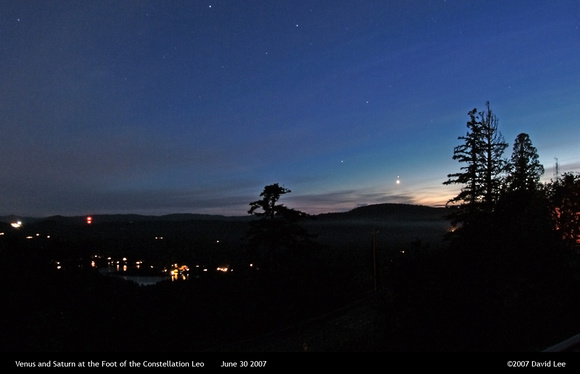Venus-Saturn Conjunction
It was beautiful evening on Saturday, June 30, 2007. A number of us were perched in the upper parking lot of the Hill watching the planetary pair glow brighter as the glow of the Sun diminished. Near the end of the evening we had a few quick looks at Jupiter. Jupiter's satellites were all lined up on one side and the surface of the planet had more detail than we've seen for a long time.
I took some wide shots of the conjunction on Saturday and noticed that I also caught the constellation Leo in the frame. I've also rebalanced the colour of my medium shot of the two planets.
I had another look at the overview shot I did with the 16mm fisheye. This is a wonderful lens to use for astronomy but it does have it's quirks. The distortion can work for you but it can be annoying if you're just going for a wide distortion free view. I've not invested in any specific tools or plugins for Photoshop but have used the Lens correction filter and and transformation functions.
There's are usually two distortions to remove. The barrel distortion is removed with the Lens correction filter. The fisheye lens I use is just an extreme version of this distortion but you'll notice that any of the ultra wides that you are using suffer from some barrel distortion but to a lesser degree. The second type of distortion comes from how far from level the lens is giving some type of keystoning effect. For this I used the transformation function (perspective).
The other interesting thing to note about processing these images taken at dusk is the challenge of getting enough signal to minimize noise. You can actually see the increase in noise as you look from west to east (right to left in the frame). On the flip side you need to avoid burning out your brighter subject matter. This was the case with the conjunction area given that Venus was so bright. In general I found I had to lift these images a fair bit because I had avoided overexposing Venus. In hindsight I probably should have exposed more.


